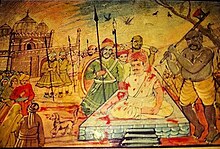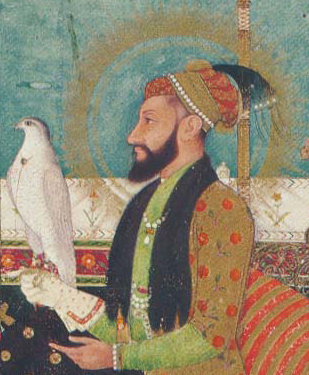
Muhi al-Din Muhammad, commonly known as Aurangzeb, was the sixth Mughal emperor, reigning from 1658 until his death in 1707. His regnal name is Alamgir I, which derived from his title, Abu al-Muzaffar Muhi-ad-Din Muhammad Bahadur Alamgir Aurangzeb Badshah al-Ghazi. Under his emperorship, the Mughal Empire reached its greatest extent with territory spanning nearly the entirety of the Indian subcontinent.

Farrukhsiyar, also spelled as Farrukh Siyar, was the tenth Mughal Emperor from 1713 to 1719. He rose to the throne after deposing his uncle Jahandar Shah. He was an emperor only in name, with all effective power in the hands of the courtier Sayyid brothers.
Raja Ram was the first Jat leader, who organised a rebellion against Aurangzeb. He was the chieftain of Sinsini. Before Rajaram the Jats were organised by different village heads dotted around Agra, Mathura and the Yamuna river. To avenge the death of Gokula, Rajaram destroyed Akbar's tomb and dragged Akbar's bones and burned them with the help of the Jat Zamindars of Braj. After his death, his brother Churaman and son Fateh Singh continued the struggle against Aurangzeb.
Mahaban is a town and a nagar panchayat in Mathura district in the Indian state of Uttar Pradesh.
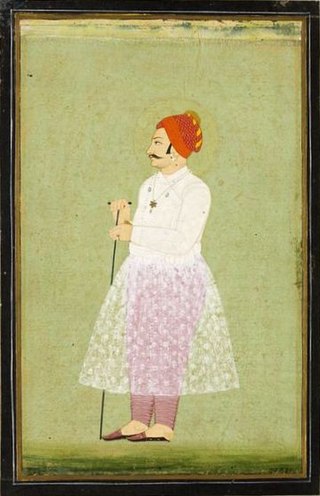
Mirza Raja Bishan Singh was the Kachwaha Rajput ruler of the Kingdom of Amer .He succeeded his grandfather Mirza Raja Ram Singh I since his father Kishan Singh died in the lifetime of his grandfather.He was also the subahdar of the province of Assam from the year 1687 to 1695 in the reigning times of Mughal Emperor Aurangzeb.He is known to have fathered one of the most eminent political icons of 18th century India i.e Sawai Jai Singh II.

Muhammad Saleh Kamboh Lahori was a noted Punjabi Muslim calligraphist and official biographer of Emperor Shah Jahan and the teacher of Mughal Emperor Aurangzeb. Though a widely read person, little is known of the life of Muhammad Saleh Kamboh other than the works he composed. He was son of Mir Abdu-lla, Mushkin Kalam, whose title shows him to also have been a fine writer. He is believed to be younger brother of Inayat-Allah Kamboh and worked as a Shahi Dewan (Minister) with the governor of Lahore. He held the title of Sipahsalar.
Bhanwari Kaur was a woman from Brij region in Uttar Pradesh, India who struggled against the oppression by Mugal ruler Aurangzeb in 1669. She was the sister of Gokula Singh, a Jat chieftain of Tilpat.

Bharatpur State, which is also known as the Jat State of Bharatpur historically known as the Kingdom of Bharatpur, was a Hindu Kingdom in the northern part of the Indian subcontinent. It was ruled by the Sinsinwar clan of the Hindu Jats. At the time of reign of king Suraj Mal (1755–1763) revenue of the state was 17,500,000 rupees per annual.The major architecture of this state include Lohagarh Fort and Deeg Palace.
The Mughal–Rajput wars were a series of battles between the Rajput Confederacy and the Mughal Empire. The conflicts originated with the invasion of northwestern India by the Mughal ruler Babur, to which the head of the Rajput confederacy, Rana Sanga, offered staunch resistance.

The Army of the Mughal Empire was the force by which the Mughal emperors established their empire in the 16th century and expanded it to its greatest extent at the beginning of the 18th century. Although its origins, like the Mughals themselves, were in the cavalry-based armies of central Asia, its essential form and structure was established by the empire's third emperor, Akbar. The regular forces mainly recruited and fielded by Mansabdar officers.

Mirza Sipihr Shikoh also known as Sipihr Shukoh, was a Mughal prince as the fourth son of Crown Prince Dara Shikoh and his consort Nadira Banu Begum.
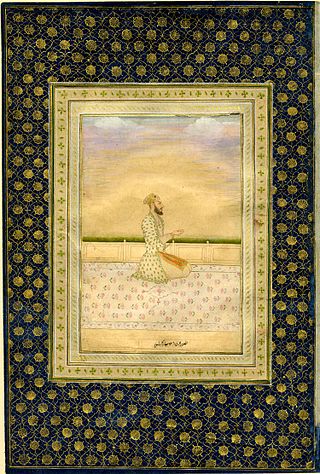
Muhammad Bidar Bakht was a Mughal prince. His father, Muhammad Azam Shah, briefly reigned as Mughal emperor in 1707. Bidar was noted for being a gallant, skilful and successful general and was regarded as the most able Mughal prince of his time. He was the favourite grandson of Emperor Aurangzeb.
Shahar Banu Begum was Empress consort of the Mughal Empire from 14 March 1707 to 8 June 1707 as the third wife of Emperor Muhammad Azam Shah. She is popularly known by the titles Padishah Bibi and Padshah Begum.
The Jat people are a traditionally agricultural community in Northern India and Pakistan. Originally pastoralists in the lower Indus river-valley of Sindh, many Jats migrated north into the Punjab region in late medieval times, and subsequently into the Delhi Territory, northeastern Rajputana, and the western Gangetic Plain in the 17th and 18th centuries. Of Hindu, Muslim and Sikh faiths, they are now found mostly in the Indian states of Punjab, Haryana, Uttar Pradesh and Rajasthan and the Pakistani provinces of Sindh and Punjab.
Parhez Banu Begum was a Mughal princess, the first child and eldest daughter of Mughal emperor Shah Jahan from his first wife, Qandahari Begum. She was also the older half-sister of her father's successor, the sixth Mughal emperor Aurangzeb.

The Subah of Lahore was a province of the Mughal Empire encompassing the central Punjab region, now divided between Pakistan and India. It was created as one of the original 12 Subahs of the Mughal Empire under the administrative reforms carried by emperor Akbar in 1580. The province ceased to exist after the death of its last viceroy, Adina Beg in 1758, with large parts being incorporated into Durrani Empire.
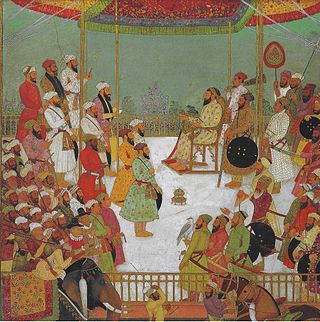
Sa'adullah Khan, also spelled Sadullah Khan was a noble of the Mughal Empire who served as the last grand vizier of Emperor Shah Jahan and Vakil-I-Mutlaq in the period 1645–1656.
The Battle of Tilpat in 1669 was fought between Jats and Mughal Subahdars. Gokula jat burnt the city of Saidabad near Mathura which caused Mughal commander Abdul Nabi Khan to attack the village of Sūra. Abdul Nabi was wounded and killed. Aurangzeb sent Hassan Ali Khan to fight the rebels. Gokul jat was captured alive in between the fight and immediately sent to Delhi.

Chowdhury Abu Torab Khan, better known simply as Abu Torab, was an 18th-century Bengali Zamindar from Sandwip, an island in present-day Bangladesh. His hegemony later extended to islands of Hatiya and Bamni. He is best known as the leader of Bengal's first rebellion against the British East India Company. He had strong support from the local peasantry, and is regarded as a hero in the history of Bengal.
